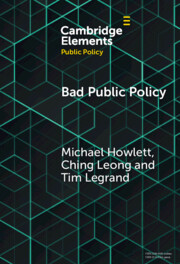Refine search
Actions for selected content:
285 results
Requirements to balance risk and multi-user experience: the case of pharmaceutical packaging design
-
- Journal:
- Proceedings of the Design Society / Volume 5 / August 2025
- Published online by Cambridge University Press:
- 27 August 2025, pp. 2751-2760
-
- Article
-
- You have access
- Open access
- HTML
- Export citation
A systematic literature review on emerging technology risks in Industry 4.0/5.0: identification, clustering and developing mitigation strategies
-
- Journal:
- Proceedings of the Design Society / Volume 5 / August 2025
- Published online by Cambridge University Press:
- 27 August 2025, pp. 299-308
-
- Article
-
- You have access
- Open access
- HTML
- Export citation
Exploring design trade-offs among sustainability, performance, and manufacturability when considering integration of new technologies
-
- Journal:
- Proceedings of the Design Society / Volume 5 / August 2025
- Published online by Cambridge University Press:
- 27 August 2025, pp. 1635-1644
-
- Article
-
- You have access
- Open access
- HTML
- Export citation
Resilience-By-Design: Standard-based definition of Resilience and identification of action fields for the systems design of mobility system
-
- Journal:
- Proceedings of the Design Society / Volume 5 / August 2025
- Published online by Cambridge University Press:
- 27 August 2025, pp. 2781-2790
-
- Article
-
- You have access
- Open access
- HTML
- Export citation
Managing technical risks caused by indirect interactions: insights from tracking the use of risk assessment tools
-
- Journal:
- Design Science / Volume 11 / 2025
- Published online by Cambridge University Press:
- 17 July 2025, e28
-
- Article
-
- You have access
- Open access
- HTML
- Export citation
Chapter 10 - More on the Current Climate in Psychiatry
- from Part II - The Present and the Future
-
-
- Book:
- Values in Psychiatry
- Published online:
- 24 June 2025
- Print publication:
- 10 July 2025, pp 139-156
-
- Chapter
- Export citation

Derivatives Pricing
-
- Published online:
- 08 July 2025
- Print publication:
- 20 March 2025
-
- Textbook
- Export citation
Walking Backward to Ensure Risk Management of Large Language Models in Medicine
-
- Journal:
- Journal of Law, Medicine & Ethics ,
- Published online by Cambridge University Press:
- 27 June 2025, pp. 1-11
-
- Article
-
- You have access
- Open access
- HTML
- Export citation
Chapter 41 - Perioperative Medicine
- from Section 4 - Walking the Walk (and Talking the Talk)
-
- Book:
- Robinson and Hall's How to Survive in Anaesthesia
- Published online:
- 09 June 2025
- Print publication:
- 26 June 2025, pp 230-232
-
- Chapter
- Export citation
Chapter 11 - Minimising Risk
- from Section 1 - Nuts and Bolts
-
- Book:
- Robinson and Hall's How to Survive in Anaesthesia
- Published online:
- 09 June 2025
- Print publication:
- 26 June 2025, pp 71-74
-
- Chapter
- Export citation
8 - Risk Management
- from Section 1 - Administration
-
-
- Book:
- Observation Medicine
- Published online:
- 27 June 2025
- Print publication:
- 26 June 2025, pp 56-58
-
- Chapter
- Export citation
Chapter 22 - Preoperative Evaluation and Preparation
- from Section 3 - Passing the Gas
-
- Book:
- Robinson and Hall's How to Survive in Anaesthesia
- Published online:
- 09 June 2025
- Print publication:
- 26 June 2025, pp 131-137
-
- Chapter
- Export citation
70 - Psychiatric Observation: Impactful Treatment and Cost-Effective Care in Lieu of Boarding
- from Subsection 4T - Clinical – Psychiatric
-
-
- Book:
- Observation Medicine
- Published online:
- 27 June 2025
- Print publication:
- 26 June 2025, pp 435-442
-
- Chapter
- Export citation
Chapter 2 - Derivatives, Market Liquidity, and Infrastructural Finance
- from Part I - Conceptual Approaches
-
-
- Book:
- The Cambridge Global Handbook of Financial Infrastructure
- Published online:
- 21 May 2025
- Print publication:
- 05 June 2025, pp 13-25
-
- Chapter
-
- You have access
- Open access
- HTML
- Export citation
Bad decisions have consequences: how cyber security could fall victim to climate change
-
- Journal:
- British Actuarial Journal / Volume 30 / 2025
- Published online by Cambridge University Press:
- 21 May 2025, e15
-
- Article
-
- You have access
- Open access
- HTML
- Export citation
Cushion option on CPPI strategy for defined-contribution pension plans
-
- Journal:
- Journal of Pension Economics & Finance , First View
- Published online by Cambridge University Press:
- 08 April 2025, pp. 1-15
-
- Article
-
- You have access
- Open access
- HTML
- Export citation

Bad Public Policy
- Malignity, Volatility and the Inherent Vices of Policymaking
-
- Published online:
- 07 April 2025
- Print publication:
- 08 May 2025
-
- Element
-
- You have access
- Open access
- HTML
- Export citation
Incident-specific cyber insurance
-
- Journal:
- ASTIN Bulletin: The Journal of the IAA / Volume 55 / Issue 2 / May 2025
- Published online by Cambridge University Press:
- 27 March 2025, pp. 395-425
- Print publication:
- May 2025
-
- Article
-
- You have access
- Open access
- HTML
- Export citation
15 - Cybersecurity and Digital Operational Resilience in Decentralised Finance
-
- Book:
- The EU Law on Crypto-Assets
- Published online:
- 28 February 2025
- Print publication:
- 06 March 2025, pp 244-265
-
- Chapter
- Export citation
Risk management in the era of data-centric engineering
-
- Journal:
- Data-Centric Engineering / Volume 6 / 2025
- Published online by Cambridge University Press:
- 20 February 2025, e15
-
- Article
-
- You have access
- Open access
- HTML
- Export citation
